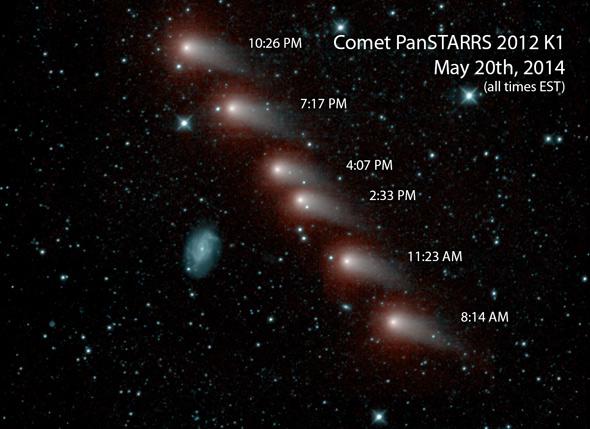Today is the Fourth of July, Independence Day in the States. By a charming coincidence, an image was released today of a comet passing the Earth, and it happens to be red, white, and blue!

Photo by NASA/JPL-Caltech
That is comet C/2012 K1 (Pan-STARRS), which is currently sweeping around the Sun. The image is actually a composite of several observations taken over a few hours on May 20, 2014. The observations are from NASA’s Wide-field Infrared Survey Explorer, or WISE. The camera detects infrared light—in this picture, what’s colored red is actually light at a wavelength of 4.5 microns, and blue is 3.4 microns (bright objects appear white, giving this photo its patriotic flair). Both colors are invisible to the unaided eye, but in comets are strongly emitted by warm dust as well as carbon monoxide and carbon dioxide.
Here’s a nifty little video showing you the comet’s movement over that day:
The comet is interesting. For one thing, it’s orbiting the Sun backwards (retrograde), so it moves in the opposite direction as the planets. For another it’s on a hyperbolic orbit, which means it’ll probably pass the Sun once and never return. That in turn means this is probably its first turn around the Sun; it’s a newbie to the inner solar system.
And that brings me to another cool thing: It doesn’t get any closer to the Sun than the Earth does. Many comets originating from very deep space dive deep near the Sun, but this one has a perihelion (the point in its orbit closest to the Sun) just outside Earth’s orbit. I don’t think that’s particularly curious scientifically, but it’s just kinda neat. I’ll note it never got anywhere near us; at closest approach to Earth in April it was well over 100 million kilometers away. It’ll make another pass in November, again at a pretty good distance.
That means it never really got bright enough for us to gawk at. Southern Hemisphere observers may get a bit of a better chance later this year, but even then it’ll most likely be a binoculars object at best.
One final note: The galaxy in the picture is the spiral NGC 3726, which happened to be in the part of the sky the comet passed through. Given that this galaxy is 50 million light years away—several trillion times farther away than the comet—the chance for a collision is somewhat minimal.
So Happy Fourth of July, my fellow Americans. I hope this comet stirs your soul a bit. And if it’s not enough, then allow me to suggest doing what I do every year on this day: Read the Declaration of Independence.